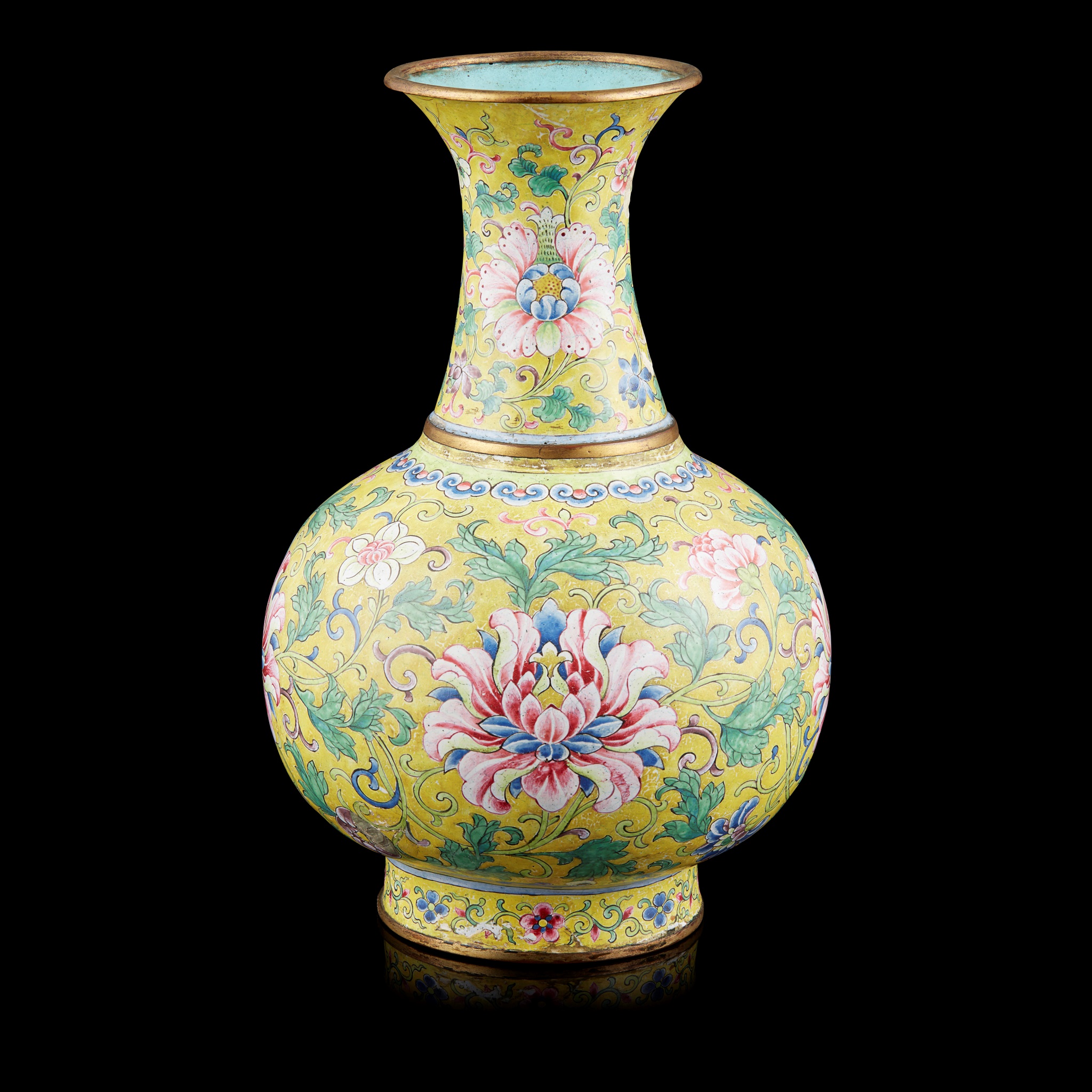RARE IMPERIAL PAINTED ENAMEL YELLOW-GROUND 'LOTUS' VASE
QIANLONG MARK AND PERIOD
£45,000
Auction: 13 May 2020 at 11:00 BST
Description
清 乾隆 銅胎畫琺瑯黃地番蓮花葉紋賞瓶 《乾隆年製》雙方框款
rising from short foot to a globular body, extending to a waisted neck and terminating to a flared rim, the exterior delicately enamelled with four blossoming lotus flowers surrounded by scrolling foliage, the body and the neck separated by a gilt bronze ring and a band of ruyi motif adorned underneath, all reserved on a richly enamelled yellow ground, the interior covered in turquoise enamel, the base inscribed with a four-character Qianlong mark within double squares in blue over the white enamelled ground
Dimensions
27cm high
Footnote
Provenance: The Earls of Crawford and Balcarres, Balcarres House, Fife, Scotland
Note: a pair of comparable painted enamel vases, similarly painted with lotus flowers reserved on a yellow ground and inscribed a four-Qianlong character mark on the base, was in the Qing Court collection and is in the collection of the National Palace Museum, Taipei, museum numbers: Gu Fa 654 & 655
Lot essay:
The vibrant enamelled yellow ground, the rich colour palette and the delicacy of the floral design employed to decorate this exquisite vase indicates that it was manufactured in the Imperial Workshops in the Forbidden City in Beijing.
Painted enamels were known as ‘foreign enamels (yang cai)’. A technique developed in Europe in Flanders, at the borders between Belgium, France and Netherlands. By the late 15th century the town Limoges, in west central France, became the centre for enamel production. As the maritime trade flourished between East and West, enamels were introduced by European missionaries to China via the trading port Canton (Guangzhou) and brought to the Qing Court by the late 17th century.[1]
The Qing court set up the Imperial Workshop in the Kangxi period (1662-1722), and started to experiment painted enamel on copper wares no later than 1713.[2] According to "Archives of the Qing Palace Workshops" in the Imperial Household Department at the Qing Court, the Imperial Workshop in Beijing, the Zaobanchu, was established by the Kangxi Emperor and had come into regular operation in the reign of the Yongzheng Emperor (1722-1735). This workshop was responsible for the production of objects and utensils used by the imperial family, and plans for each object had to be submitted for official approval. In the early period, due to insufficient technical knowledge of painted enamel, only small vessels were made, with limited palette and murky colours. By the late Kangxi period and Yongzheng reign, a wider range of brighter and purer colours became available, resulting in clearer decorations and a higher level of technical sophistication.
The design of the lotus flower, as beautifully shown in the present lot, is in continuation of painted enamel wares on porcelain and copper produced during the Yongzheng reigns. The colour palette, as well as the painting style, display western influence bearing witness to the cross-fertilisation of Asian and Western cultures at the Imperial Court.
Two comparable pairs of painted enamel vases with a lemon-yellow ground used by the Imperial Court were in the Qing Court collection and are now in the collection of the National Palace Museum, Taipei. One pair is marked and period of Yongzheng, both the bulbous body and the neck similar decorated with a blossoming lotus flower in red and blue colour, separated by a band of metal ring around the shoulder.[3] The other pair of similar decoration bears a four-character Qianlong (1736-1795) mark within double squares in blue on the base.[4] It is worth noticing that each vase is mounted with a pair of bronze dragon-shaped handles. In comparison, the current example has symmetrical holes on either side of the neck, from where the handles, possibly of bronze dragon form, would have been removed at a later date.
[1] Soulie de Morant, Historie de l’art Chinois, p.23; cited from Shi, Jingfei, Luminance: the painted enamelware of the Qing Imperial court, Taipei, National Palace Museum, 2012, p. 243, footnote 340
[2] Shi, Jingfei, ibid, p. 21
[3] National Palace Museum, Taipei, museum collection nos. Gu Fa 941 & 942
[4] National Palace Museum, Taipei, museum collection nos. Gu Fa 654 and 655

